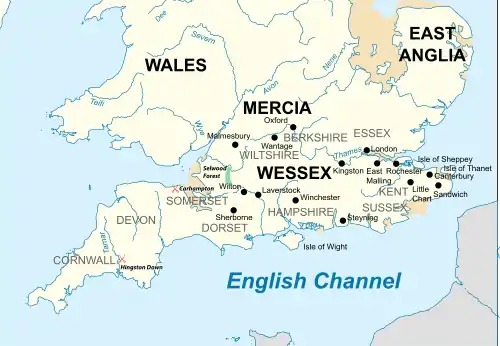| Battle of Hingston Down | |||||||
|---|---|---|---|---|---|---|---|
| Part of the Viking invasions of England | |||||||
| |||||||
| Belligerents | |||||||
| Anglo-Saxons |
Cornish Danish Vikings | ||||||
| Commanders and leaders | |||||||
| Egbert | Unknown | ||||||
| Casualties and losses | |||||||
| Unknown | Unknown | ||||||

The Battle of Hingston Down took place in 838, probably at Hingston Down in Cornwall between a combined force of Cornish and Vikings on the one side, and West Saxons led by Ecgberht, King of Wessex on the other. The result was a West Saxon victory.[1] According to the Anglo-Saxon Chronicle, which called the Cornish the West Welsh:
- In this year a great naval force arrived among the West Welsh, and the latter combined with them and proceeded to fight against Ecgberht, king of the West Saxons. When he heard that, he then went hither with his army, and fought against them at Hingston Down, and put both the Welsh and the Danes to flight.[2]
Most historians of the period identify the site of the battle as Hingston Down north-east of Callington in Cornwall,[3] but others argue for Hingston Down near Moretonhampstead, Devon.[4][5][6]
The British kingdom of Dumnonia, which covered Devon and Cornwall, survived into the early eighth century, when eastern Devon was conquered by Wessex. Conflict continued throughout the 8th century with Wessex pushing further west. In 815 King Egbert raided Cornwall 'from east to West' which, given later battles at Gafulford and Hingston Down probably indicates the conquest of the remaining parts of West Devon.
This was the last recorded battle between the Cornish and the West Saxons and ended roughly a century of warfare that began at the Battle of Llongborth in 710 (see Geraint of Dumnonia). The last known king of Cornwall, Dungarth, died in 875, but he is thought to have been an under-king subject to Wessex.[7]
References
- ↑ Charles-Edwards, p. 92
- ↑ Whitelock, p. 187
- ↑ Charles-Edwards, p. 431; Hadley, p. 200; Stenton, p. 235
- ↑ Fletcher, John (2022). The Western Kingdom. Cheltenham: The History Press. pp. 88–90. ISBN 9781803990002.
- ↑ Weatherhill, Craig. "Where was Hengestdun?". Cornish World Magazine. Archived from the original on 17 January 2013. Retrieved 5 August 2022.
- ↑ Fletcher, John. "Vikings and Settlers in Cornwall". Projekt Forlg. Archived from the original on 21 April 2023. Retrieved 14 November 2023.
- ↑ Charles-Edwards, pp. 428-31; Padel, "Cornwall"; Davies, p. 342; Stenton, p. 235
Sources
- Charles-Edwards, Thomas (2013). Wales and the Britons 350–1064. Oxford University Press. ISBN 978-0-19-821731-2.
- Davies, John Reuben (2013). "Wales and West Britain". In Stafford, Pauline (ed.). A Companion to the Early Middle Ages: Britain and Ireland c.500-c.1100. Wiley-Blackwell. ISBN 978-1-118-42513-8.
- Hadley, Dawn (2013). "Viking Raids and Conquest". In Stafford, Pauline (ed.). A Companion to the Early Middle Ages: Britain and Ireland c. 500–c. 1100. Chichester, West Sussex: Wiley-Blackwell. pp. 195–211. ISBN 978-1-118-42513-8.
- Padel, O. J. (2014). "Cornwall". In Lapidge, Michael; Blair, John; Keynes, Simon; Scragg, Donald (eds.). The Wiley Blackwell Encyclopedia of Anglo-Saxon England (2nd ed.). Chichester, UK: Wiley Blackwell. ISBN 978-0-470-65632-7.
- Stenton, Frank (1971). Anglo-Saxon England (3rd ed.). Oxford University Press. ISBN 978-0-19-280139-5.
- Whitelock, Dorothy, ed. (1979) [1st edition 1955]. English Historical Documents, Volume 1, c. 500–1042 (2nd ed.). London, UK: Routledge. ISBN 978-0-415-14366-0.